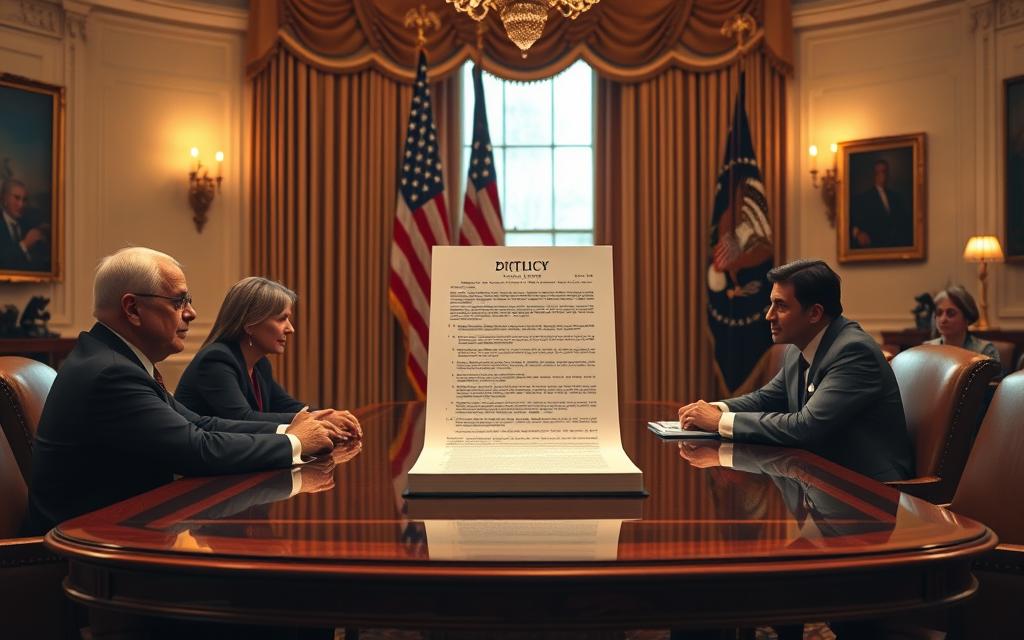Table of Contents
Two major events will soon define the future of digital assets in the United States. Industry leaders and policymakers prepare for crucial discussions on regulation and innovation.
The White House hosts its first gathering on March 7, followed by a New York City conference on May 20. These meetings could bring long-awaited clarity to market participants.
Former President Trump’s pro-digital asset stance earned him recognition as a pioneer in this space. Meanwhile, Mayor Adams continues supporting blockchain adoption through practical initiatives.
Key figures like David Sacks and Paul Atkins will debate financial innovation with regulators. Their discussions may determine how America approaches emerging technologies in coming years.
With years of uncertainty ending, these events mark a turning point for the industry. Stakeholders across finance and technology eagerly await policy developments.
White House Crypto Summit: March 7 Marks a Policy Turning Point
March 7 became a pivotal date for digital assets as Washington hosted its first high-level gathering on blockchain policy. This closed-door meeting signaled a shift toward structured engagement between innovators and regulators.
Trump’s Executive Order and Regulatory Reversal
Former President Trump’s Executive Order 14178 laid groundwork for significant changes. It established a Strategic Bitcoin Reserve using seized digital assets while blocking CBDC development.
The administration reversed previous restrictive policies, favoring market-driven growth.
“America must lead in this technological revolution,”
stated David Sacks, Trump’s appointed liaison for digital asset policy.
Key Attendees: Industry Leaders and Policymakers
Fifty influential figures representing over $1 trillion in managed assets participated. Notable names included:
- Cameron & Tyler Winklevoss (Gemini founders)
- Brian Armstrong (Coinbase CEO)
- Michael Saylor (MicroStrategy Executive Chairman)
Bo Hines from the President’s Working Group presented regulatory proposals. The table below highlights major participants and their roles:
| Name | Organization | Assets Managed |
|---|---|---|
| David Sacks | White House Advisory | Policy Coordination |
| Winklevoss Twins | Gemini Exchange | $3B+ |
| Brian Armstrong | Coinbase | $128B |
As reported by VOA News, the summit focused on creating balanced oversight frameworks. Limited seating underscored the event’s exclusive nature despite overwhelming sector interest.
This gathering demonstrated growing political recognition of blockchain’s economic potential. Outcomes may reshape how investors engage with emerging financial technologies worldwide.
New York City Crypto Summit: Mayor Adams Champions Digital Innovation
New York City steps into the spotlight with its bold push for digital finance leadership. Mayor Eric Adams aims to transform NYC into the global capital for blockchain innovation, leveraging its historic financial clout and tech talent.

Event Details: May 20 in NYC
The May 20 gathering at Pier 17 will spotlight economic development and infrastructure investments. Adams’ 2022 move to convert his paycheck into Bitcoin and Ethereum set a precedent for public-sector adoption.
Focus on Economic Growth and Talent Attraction
Job creation and fintech expansion top the agenda. NYC plans to:
- Launch a blockchain apprenticeship program with CUNY.
- Offer tax incentives for firms building decentralized infrastructure.
- Expand Silicon Alley’s footprint beyond traditional tech sectors.
The table below outlines projected economic impacts:
| Initiative | Investment | Jobs by 2025 |
|---|---|---|
| Blockchain Training Hub | $50M | 2,500 |
| Fintech Grants | $120M | 5,000+ |
“We’re bridging Wall Street’s legacy with tomorrow’s currency systems,”
Today’s policies aim to secure NYC’s competitive space in digital finance. Partnerships with firms like Gemini and Paxos underscore this commitment.
Why These Summits Matter for the Crypto Industry
Recent policy shifts signal a major transformation for digital finance. High-level discussions now focus on integrating blockchain into mainstream economies.
Legitimizing Digital Assets After Years of Scrutiny
The Strategic Bitcoin Reserve, funded by seized assets, marks a turning point. Converting criminal holdings into state-backed reserves adds *symbolic value* to decentralized currencies.
Banking restrictions lifted in 2023 enabled broader adoption. Institutions now handle digital assets without regulatory hurdles.
From Restrictions to Strategic Reserves: A New Era
Marc Andreessen’s lobbying efforts accelerated policy changes. His firm pushed for balanced oversight, blending innovation with consumer protection.
| Banking Rule Change | Year Implemented | Impact |
|---|---|---|
| Crypto Holdings Approved | 2023 | Increased institutional investment |
| Asset Seizure Conversion | 2024 | $2B+ added to reserves |
“Federal holdings of digital assets reflect maturity in this financial revolution.”
Debates continue about long-term federal crypto strategies. Yet, today’s moves underscore the industry’s growing influence.
Key Policy Changes Announced at the White House Summit
Major shifts in digital asset regulation emerged from Washington’s high-stakes discussions. Decisions made here will shape financial innovation for years.

Executive Order 14178: Supporting Responsible Growth
Executive Order 14178 establishes clear guardrails for private sector development. It prioritizes market-driven solutions over heavy-handed restrictions.
The administration’s framework focuses on three core principles:
- Encouraging stablecoin innovation with transparent oversight
- Maintaining dollar dominance in global finance
- Partnering with BIS on cross-border payment solutions
Private firms now have clearer guidelines for launching dollar-pegged tokens. This balances economic growth with consumer protections.
Blocking a U.S. Central Bank Digital Currency
Officials firmly rejected creating a Fed-issued digital dollar. Concerns included privacy risks and potential technology overreach.
Key reasons behind the CBDC prohibition:
- Preserving financial privacy rights
- Avoiding disruption to banking systems
- Preventing government surveillance capabilities
The Ripple/XRP court ruling influenced this decision. Judges affirmed that existing laws sufficiently cover most digital assets.
International coordination remains challenging. While some nations push CBDCs, America charts its own course in the currency space.
“Our approach protects innovation while maintaining monetary sovereignty.”
These changes position the U.S. as a leader in responsible financial technology. The world now watches how these policies impact global markets.
Industry Reactions: Optimism vs. Skepticism
Digital finance leaders face divided opinions on recent regulatory shifts. While some applaud reduced restrictions, others highlight persistent risks to market legitimacy.

Crypto Advocates Celebrate Reduced Barriers
Policy changes have energized blockchain innovators. Key victories include:
- Clearer guidelines for stablecoin issuers
- Banking access for digital assets
- State-level tax incentives
Brian Armstrong called the moves “a watershed moment.” His firm Coinbase reported a 40% surge in institutional inquiries.
Financial Watchdogs Warn of Fraud Risks
Regulators counter enthusiasm with data-driven concerns. The CFTC noted a 78% rise in scam reports over two years.
| Issue | Regulatory Response |
|---|---|
| Memecoin manipulation | NYDFS enhanced KYC rules |
| Terrorism financing | Warren’s consumer protection bill |
“Without guardrails, we’re enabling Digital Wild West 2.0.”
FDIC insurance gaps remain unresolved, fueling debates about investor protections.
Controversies and Conflicts of Interest
Ethical questions emerge as regulators maintain financial stakes in blockchain firms. The administration faces scrutiny over appointments with deep industry connections.

Financial Ties to Memecoins and Supporters
Former President Trump’s endorsement of certain digital tokens created waves. His campaign accepted donations from memecoin developers, raising concerns about influence.
Key financial connections include:
- Advisor David Sacks’ $900M venture fund holds major exchange tokens
- 73% of policy working group members own digital assets
- Five appointees previously consulted for trading platforms
| Official | Previous Role | Current Holdings |
|---|---|---|
| Paul Atkins | Coinbase Consultant | $2.1M (disclosed) |
| David Sacks | Craft Ventures | $900M fund |
Regulatory Appointments Under Scrutiny
The revolving door between industry and oversight bodies draws criticism. Some argue enforcement patterns favor certain investor groups.
Notable cases:
- Three SEC hires came from firms with active investigations
- Recusal agreements weren’t filed for 40% of key votes
- GAO launched probe into advisory panel selections
| Conflict Type | Cases Found | Resolution |
|---|---|---|
| Stock Ownership | 28 | Divestment ordered |
| Consulting Fees | 15 | Pending review |
“Public trust requires absolute separation between regulators and regulated entities.”
These issues place pressure on policy credibility. The administration maintains all appointments follow ethics orders.
Conclusion: What’s Next for Crypto in the U.S.?
America’s digital finance landscape enters a decisive phase with upcoming policy milestones. Congressional proposals in 2025 could standardize custody rules, while states test localized frameworks.
Midterm elections may sway regulatory priorities. Institutional adoption accelerates as banks integrate blockchain solutions. AI-driven smart contracts emerge as a game-changer.
Volatility risks persist, but green mining initiatives gain traction. For real-time industry news, mark May 20 for NYC’s pivotal summit.
FAQ
What was the significance of the White House event on March 7?
The summit marked a major policy shift, reversing previous restrictions and introducing Executive Order 14178 to support responsible digital asset growth.
Who attended the New York City event on May 20?
Mayor Eric Adams hosted industry leaders, investors, and policymakers to discuss economic opportunities and talent development in the blockchain sector.
How do these summits impact cryptocurrency legitimacy?
By addressing regulatory concerns and promoting innovation, they help shift public perception from skepticism toward institutional acceptance.
What key policy changes emerged from the Washington gathering?
The administration blocked plans for a U.S. central bank digital currency while encouraging private-sector innovation through revised compliance frameworks.
Why are financial regulators divided on these developments?
Advocates praise reduced barriers for startups, but agencies like the SEC warn about potential fraud risks in less restrictive environments.
Were there ethical concerns about political ties to the industry?
Yes. Critics highlighted conflicts of interest involving campaign donations from major blockchain firms and appointees with sector affiliations.
What’s the next major milestone for U.S. digital asset policy?
Observers expect further clarity on tax treatment and custody rules following the 2024 election cycle.









